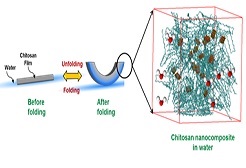Santhosh Mathesan
IIT Madras, India
Title: Water content dependent mechanical properties of biopolymer thin films: A molecular dynamics study
Biography
Biography: Santhosh Mathesan
Abstract
Moisture responsive biopolymers are gaining importance due to its capability to replicate the stimuli responsive behavior observed in nature. They are three dimensional polymer network structure which changes its volume, by retaining large quantity of water. They have wide range of applications in actuators, water purification and flow controlling valves. Self-folding is a well-known response observed in water responsive biopolymers. In the presence of water, the film experiences inhomogenous swelling maintaining it in differential stressed state. The differential stress state assists the film to exhibit self-folding phenomenon. Also, the water content in consecutive layers varies across thickness of the film. Thus, modifying the mechanical properties and diffusion characteristics of each layer of biopolymer film. Chitosan (CS) is a moisture responsive biopolymer which can demonstrate self-folding phenomenon. However, chitosan film shows structural instability during self-folding due to its lower mechanical properties and higher swelling capacity. Strength of biopolymers are either enhanced by cross-linking process or reinforcing with nanofillers. Here, chitosan matrix is reinforced with hydroxyapatite (HAP) to modify its mechanical properties. Though HAP enhances the strength of CSHAP film in dry state, diffusion of water alters its mechanical properties during the folding phenomenon. Therefore, it is necessary to understand the influence of water on mechanical properties of pristine CS and HAP reinforced chitosan. Molecular dynamics (MD) simulation is one of the promising tools to explore the mechanism behind macroscopic properties. In this work, we will present the influence of varying water content on directional dependent mechanical properties of CS and CSHAP nanocomposite systems. For these systems, the stiffness matrix will be determined by applying constant strain minimization technique in MD. It can be correlated with the direction dependent diffusion coefficient matrix explaining the self-folding process. Nano-mechanical characterization of CS and CSHAP in the dry and wet state will be performed using depth sensing nanoindentation. This technique will be complementing the results observed in MD simulation.

Recent Publications
- Johnson B D, Beebe D J, Crone W C (2004) Effects of swelling on the mechanical properties of a pH-sensitive hydrogel for use in microfluidic devices Mater. Sci. Eng. C 24 575–581.
- Fernandes R, Gracias D H (2012) Self-folding polymeric containers for encapsulation and delivery of drugs Adv. Drug Deliv. Rev. 64 1579–1589.
- Franca E F, Freitas L C G, Lins R D (2011) Chitsosan molecular structure as a function of N-acetylation Biopolymers, 95 448-460.
- Mathesan S, Rath A, Ghosh P (2015) Molecular mechanisms in deformation of cross-linked hydrogel nanocomposite Mater. Sci. Eng. C 59 157-167
- Rath A, Mathesan S, Ghosh P (2015) Nanomechanical characterization and molecular mechanism study of nanoparticle reinforced and cross-linked chitosan biopolymer J. Mech. Behav. Biomed. Mater 55 42-52.

